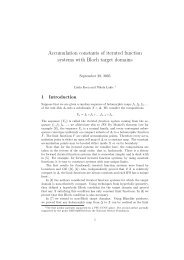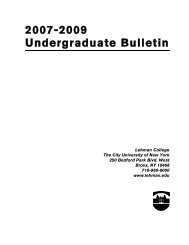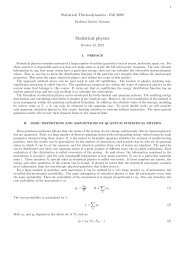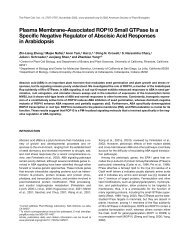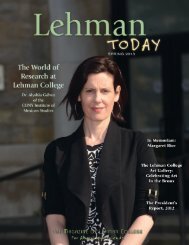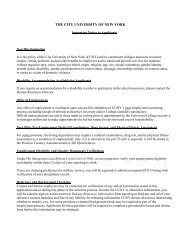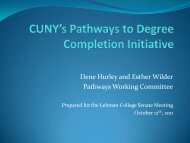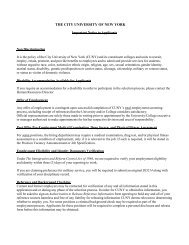You also want an ePaper? Increase the reach of your titles
YUMPU automatically turns print PDFs into web optimized ePapers that Google loves.
ookshelf<br />
Angels of Mercy: White Women and the History of<br />
New York’s Colored Orphan Asylum<br />
(Fordham University Press, <strong>2011</strong>). William Seraile. $27.95 (cloth); $20 (paper).<br />
In his new book, Professor Emeritus William Seraile of <strong>Lehman</strong>’s<br />
African and African-American Studies Department uncovers a<br />
forgotten chapter of New York City history: the more than a century<br />
old Colored Orphan Asylum that housed thousands<br />
of young African-American children in the nineteenth<br />
and twentieth centuries. The Orphan Asylum—as it<br />
was called then—was a place where poor children<br />
were wards of the state. Many were actual orphans,<br />
but many others were not. As Dr. Seraile details in<br />
this thought-provoking book, their young lives were<br />
anything but easy.<br />
At age twelve, they were sent away from the orphanage—in some<br />
cases, the only home they had ever known—to work as indentured<br />
servants on farms; boys worked the land, while girls became<br />
domestic servants. Their stories on these farms are heart-wrenching:<br />
Abuse was rampant; some were whipped. Sometimes the only<br />
familial bonds they had were ruptured when they left the asylum.<br />
Dr. Seraile recalls reading letters of older siblings to Orphan<br />
Asylum managers, looking for the whereabouts of their younger<br />
siblings; it was unclear from his research, he said, if these children<br />
ever received a response.<br />
As you can imagine, adjusting to completely new circumstances,<br />
losing the only home they ever knew, and performing adult labor at<br />
such a young age was often unbearably difficult. There are stories<br />
of children acting out, setting fire to barns, and killing employees.<br />
One former Asylum child left his employer, walking<br />
100 miles on foot back to the orphanage,<br />
only to be turned away. “They couldn’t take him<br />
back,” says Dr. Seraile. “It was against the law.”<br />
The child eventually returned—again on foot—<br />
to the farm.<br />
There is also ample evidence, as he discovered in<br />
the New-York Historical Society and the Schomburg<br />
Center for Research in Black Culture, that some children were<br />
treated kindly by their employers, even rewarded with property of<br />
their own. Others went on to serve their country in the Civil War.<br />
One such Asylum resident was James Henry Gooding, an African-<br />
American soldier who wrote a famous letter to President Abraham<br />
Lincoln in January 1863, protesting that soldiers like himself were<br />
paid less than their white counterparts—$10 a month, while whites<br />
received $13. Soon thereafter, Congress changed the law and<br />
gave both sets of soldiers equal pay.<br />
Over time, children from the orphanage became musicians, lawyers,<br />
doctors, teachers, nurses, and police officers, among other professions.<br />
Despite the hardships, the institution was a nurturing place<br />
for many of its residents.<br />
Originally located in mid-Manhattan from 1836 until July 1863,<br />
when it was burned down in the draft riots that occurred during the<br />
Civil War, the orphanage eventually relocated to northern Riverdale,<br />
to the site overlooking the Palisades now occupied by the Hebrew<br />
Home for the Aged. In 1944 it moved again, this time to Harlem;<br />
in 1989 it changed its name to the Harlem Dowling–West Side<br />
Center for Children and Family Services. No longer an orphanage,<br />
it became a foster home and counseling center for families. <br />
Living This Life Fully: Stories and Teachings<br />
Of Munindra<br />
(Shambhala Publications, Oct 2010). Mirka Knaster.<br />
As an immigrant in New York, Dr. Mirka Knaster (B.A., ’68) grew<br />
up at home with several languages—Yiddish, Polish, German, and<br />
Hebrew—while learning English. She added Spanish, French, and<br />
Italian, with a smattering of Latin and Greek, at Hunter-in-the-<br />
Bronx (now <strong>Lehman</strong>).<br />
“I’ve always loved to read, whatever the idiom,” she says.<br />
“I can still remember the thrill of getting my first library<br />
card. Books introduced me to new worlds and helped<br />
me imagine and believe in possibilities beyond the life<br />
I knew. But I never imagined that I’d be writing books<br />
myself some day.”<br />
Logically, you’d expect Dr. Knaster to choose a career<br />
as a professional translator or linguist. Her interest in how other<br />
6 <strong>Lehman</strong> Today/<strong>Spring</strong> <strong>2011</strong><br />
people live, however, led her to explore cultures<br />
around the world, especially with respect to<br />
women, healing arts, and spiritual traditions.<br />
After graduation, when she won a full scholarship<br />
to the Ph.D. program in Spanish at Brown University,<br />
she was surprised to find that graduate school<br />
was not more challenging than college had been.<br />
Deciding instead to teach English at a university<br />
in Colombia—”where Spanish really came<br />
alive for me in an everyday way”—she traveled<br />
throughout South and Central America, Mexico,<br />
and the Caribbean.<br />
Those experiences led her back to graduate<br />
school, this time in Latin American Studies at<br />
Stanford University, where she earned an M.A. and won a postgraduate<br />
Ford Foundation grant. Several years later, her focus<br />
shifted to Asia. After training in body therapies, and spending time<br />
teaching them, she headed for the East in 1981 to investigate<br />
cross-cultural healing arts.



